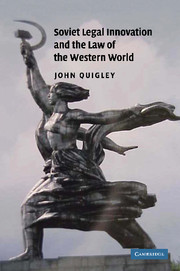Book contents
- Frontmatter
- Contents
- Abbreviations
- Preface
- Acknowledgments
- PART ONE THE SOVIET CHALLENGE
- PART TWO THE WEST ACCOMMODATES
- 8 Panic in the Palace
- 9 Enter the Working Class
- 10 Social Welfare Rights
- 11 The State and the Economy
- 12 Equality Comes to the Family
- 13 Child-Bearing and Rights of Children
- 14 Racial Equality
- 15 Crime and Punishment
- PART THREE THE BOURGEOIS INTERNATIONAL ORDER
- PART FOUR LAW BEYOND THE COLD WAR
- Notes
- Bibliography
- Index
13 - Child-Bearing and Rights of Children
Published online by Cambridge University Press: 27 July 2009
- Frontmatter
- Contents
- Abbreviations
- Preface
- Acknowledgments
- PART ONE THE SOVIET CHALLENGE
- PART TWO THE WEST ACCOMMODATES
- 8 Panic in the Palace
- 9 Enter the Working Class
- 10 Social Welfare Rights
- 11 The State and the Economy
- 12 Equality Comes to the Family
- 13 Child-Bearing and Rights of Children
- 14 Racial Equality
- 15 Crime and Punishment
- PART THREE THE BOURGEOIS INTERNATIONAL ORDER
- PART FOUR LAW BEYOND THE COLD WAR
- Notes
- Bibliography
- Index
Summary
The early Soviet reforms on paternity and adoption evoked little reaction abroad. The idea of collective paternity was abandoned in 1926 in the USSR itself, as was the abolition of private-family adoption. Neither idea was seriously considered in other countries. Soviet reforms on child-care, on illegitimate children, and on abortion exerted considerable impact beyond the borders of the USSR.
Laws on these issues underwent a sea change in the middle years of the twentieth century, taking the direction followed by the early Soviet legislation. Communal facilities for child day care came into common use, as an adjunct to the entry of women into the workforce. The status of children born out of wedlock was regularized.
Abortion Policy
In the 1920s, a prohibition against abortion was still the nearly universal rule in the West. Criminal penalties, often with severe punishments, applied to the performance of an abortion. Despite the prohibition, however, abortions were performed, often in improper medical conditions, and this fact helped keep the issue one of great public controversy.
The 1920s saw the abortion issue high on the medical agenda in many countries, and being raised as well as a political issue. The Soviet experience figured heavily. The Soviet decision in 1920 to legalize abortion “was very important for the abortion debate in other countries.” In Switzerland, leftist parties campaigned in the 1920s to legalize abortion.
Legalization campaigners pointed to the 1920 Soviet decree to show that legalization was possible.
- Type
- Chapter
- Information
- Soviet Legal Innovation and the Law of the Western World , pp. 108 - 114Publisher: Cambridge University PressPrint publication year: 2007



